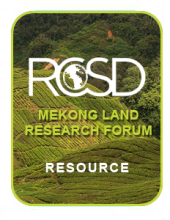Land Library
Welcome to the Land Portal Library. Explore our vast collection of open-access resources (over 74,000) including reports, journal articles, research papers, peer-reviewed publications, legal documents, videos and much more.
/ library resources
Showing items 1 through 9 of 24.Drylands have potential for economic activity now markets are emerging for natural products such as aloe or gum Arabic. However it is difficult to take advantage of these opportunities because there is a lack of structure for this market.
This paper analyzes how women’s participation affects institutional outcomes related to the decentralized governance of community forests in Madhya Pradesh, India.
This participatory poverty assessment (PPA 2006) comprises one component of ADB’s Technical Assistance to the Lao People’s Democratic Republic for Institutional Strengthening for Poverty Monitoring and Evaluation.
This paper conducts an empirical investigation of the rural credit market in Myanmar to help guide policy formulation on the microfinance operations in the country.
Policymaking initiatives in agriculture and public health are often pursued in a parallel and unconnected fashion. Yet coherent, joint action in agriculture and health could have large potential benefits and substantially reduce risks for the poor.
The conference reviewed the current state-of-knowledge of dryland ecosystems; it identified important knowledge gaps for defining future paths of research into drylands; and it commemorated fifty years of dryland research in the UN system in the context of the International Year of Deserts and D
The Government of Namibia has identi ed land degradation as a serious problem which demands remedial intervention, and recognizes that integrated ecosystem management strategies are needed to e ectively address the underlying causes.The goal of the Country Pilot Partnership for Integrated Sustain
To address the needs of individual regions, such as LAC, more detailed regional and sub regional strategies are needed to ensure that forestry contributes fully to the challenges of poverty, inequity, environmental degradation and sustainable development.






